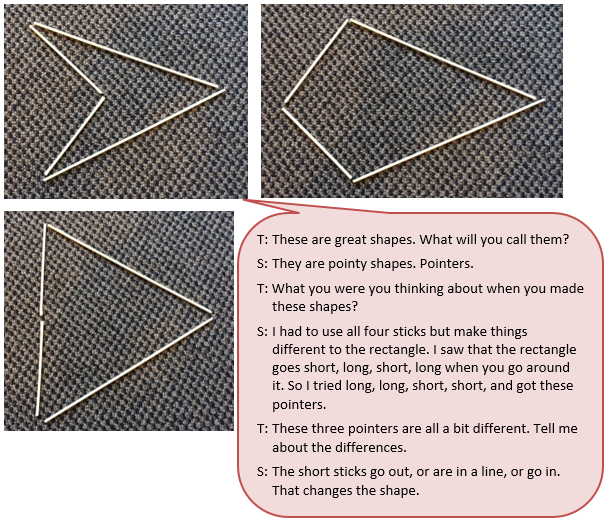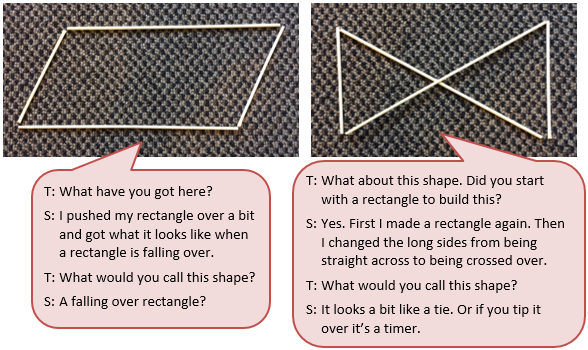The purpose of this activity is to engage students in thinking about the features of a 2D shape.
The activity assumes the students have experience in the following areas.
- Constructing polygons by drawing or joining strips.
- Naming common polygons, such as triangle, square, rectangle, hexagon, octagon.
- Describing the features of polygons (feature are perceptual characteristics such as sharpness, straightness, ability to roll, etc.).
- Identifying simple properties of polygons, such number of sides and angles.
The problem is sufficiently open ended to allow the students freedom of choice in their approach. It may be scaffolded with guidance that leads to a solution, and/or the students might be given the opportunity to solve the problem independently.
The example responses at the end of the resource give an indication of the kind of response to expect from students who approach the problem in particular ways.

We can use two short sticks and two long sticks to build a rectangle.
What other shapes can we make from these four sticks? Give each of your shapes a name.
Note to teacher: This activity requires materials for manipulation. The sticks could be actual sticks or just strips of paper.
The following prompts illustrate how this activity can be structured around the phases of the Mathematics Investigation Cycle.
Make sense
Introduce the problem. Allow ākonga time to read it and discuss in pairs or small groups.
- What do you think the problem is about?
- What do you need to do?
- What are you allowed to do and what are you not allowed to do?
- Do you need to use all the sticks to make a shape?
- What part of the problem could you get started with?
- Can you rephrase the problem in your own words? (What shapes can we make from two long sticks and two short sticks?)
Plan approach
Discuss ideas about how to solve the problem. Emphasise that for now you want ākonga to say how they would solve the problem, not to actually solve it.
- What strategies can you use to get started?
- In what ways might you arrange the sticks?
- Can you make shapes from just two sticks? Why not?
- Can you make shapes from three sticks?
- How will you record the shapes you make so that you can make others?
- Can you try some ideas out and check if they work?
Take action
Allow ākonga time to work through their strategy, and find a solution to the problem.
- Have you recorded your ideas in a way that helps you to see patterns?
- What set of sticks did you try first? Did you try all four sticks?
- Did you make all the shapes that you could have with the four sticks?
- What patterns did you find?
- What shapes were impossible to make? Why?
- Is there another possible answer you might have missed?
Convince yourself and others
Allow ākonga time to check their answers and then either have them pair share with other groups or ask for volunteers to share their solution with the class.
- What is your solution?
- Do you have a set of shapes? Do the shapes have anything in common?
- Can you name your shapes?
- Can you convince someone else that the shape is a rectangle, or a triangle?
- Could you make different shapes if you try different ways to organise the sides and angles?
- How does your solution answer the question?
- What might you do differently next time?
Examples of work
Work sample 1
The student uses materials to create different polygons and describes the polygons using features like ‘pointiness’ and “straightness.’
Click on the image to enlarge it. Click again to close.
Work sample 2
The student creates different polygons and describes the polygons using features and properties, such as ‘falling over’ and intersection “crossing over’ of sides. They have names for some simple polygons.

